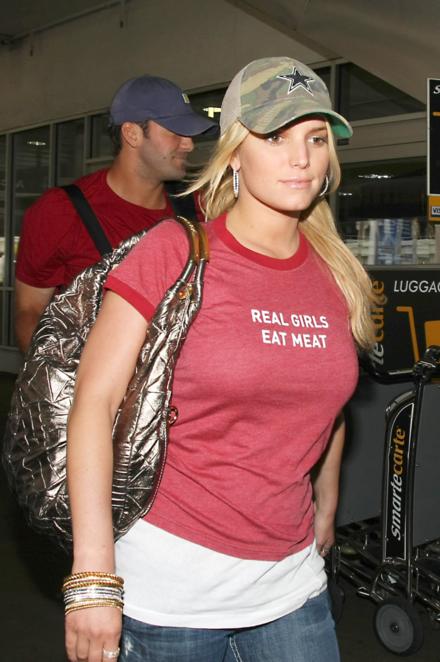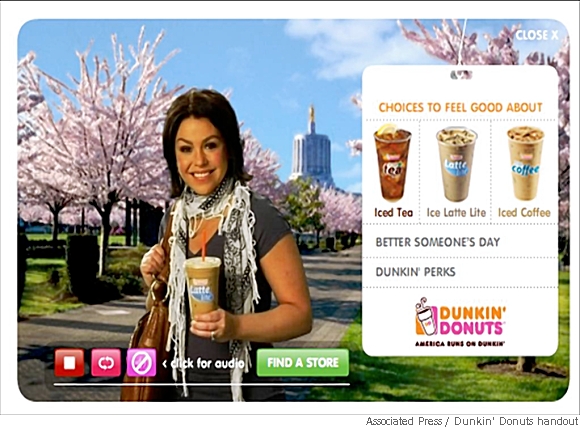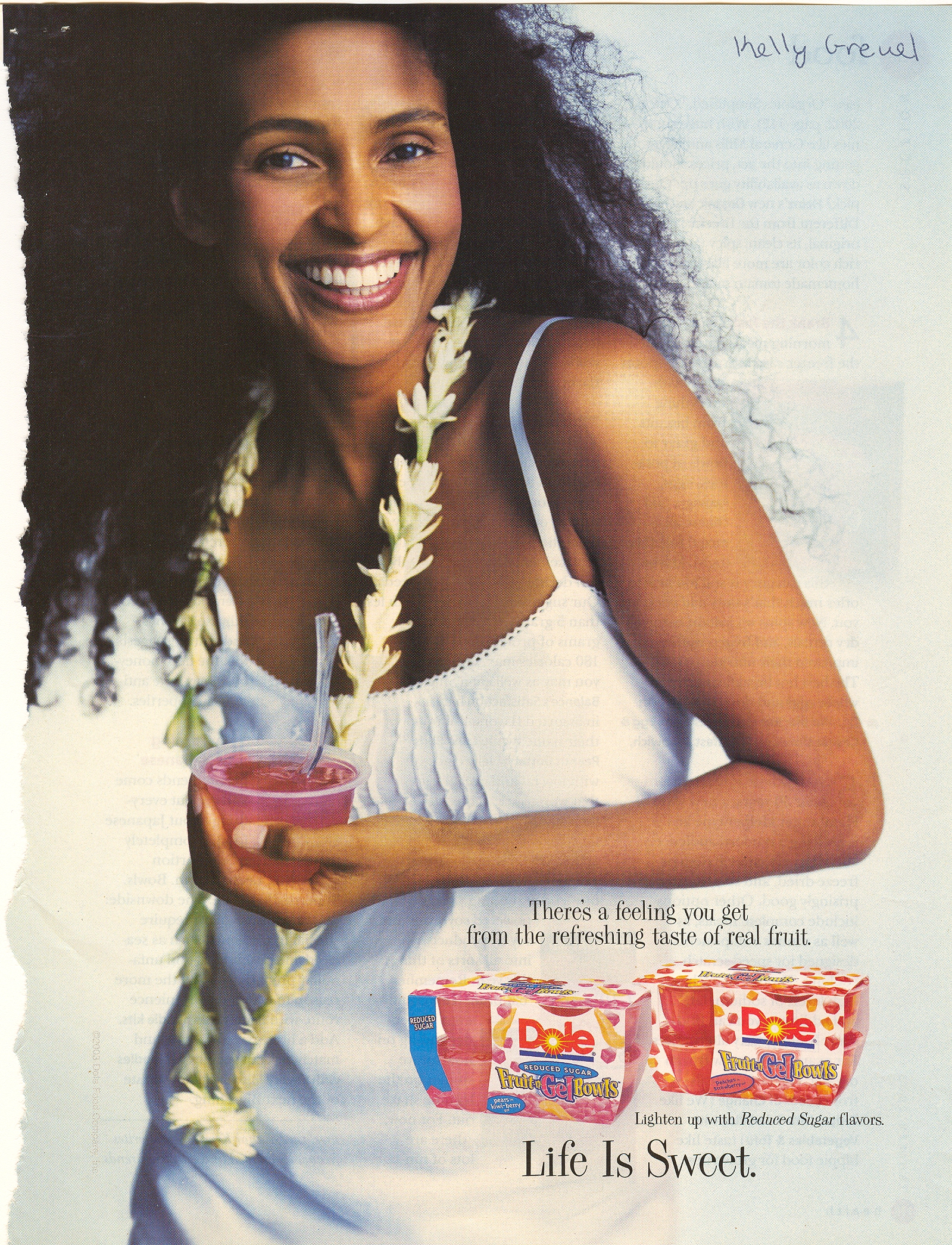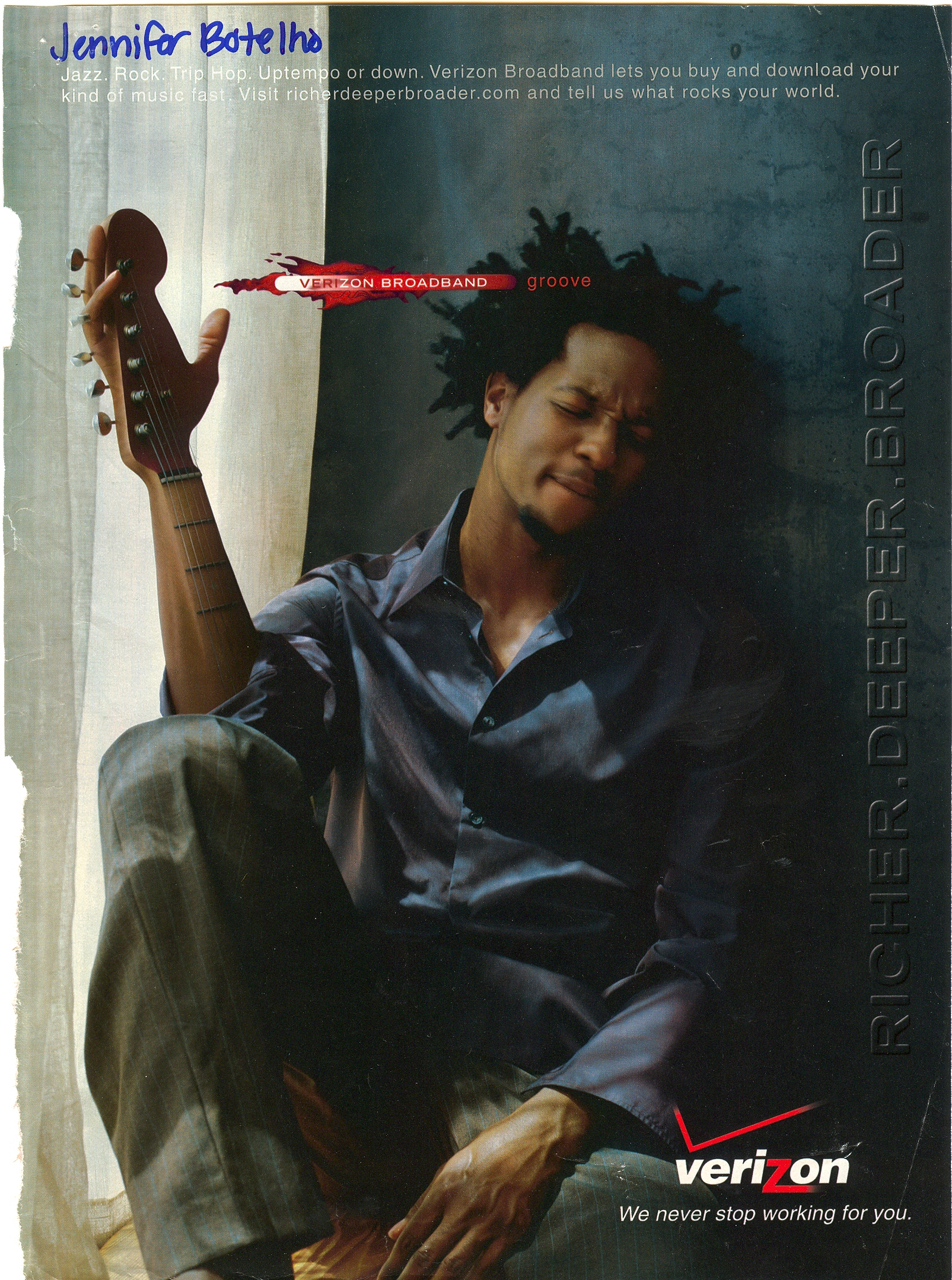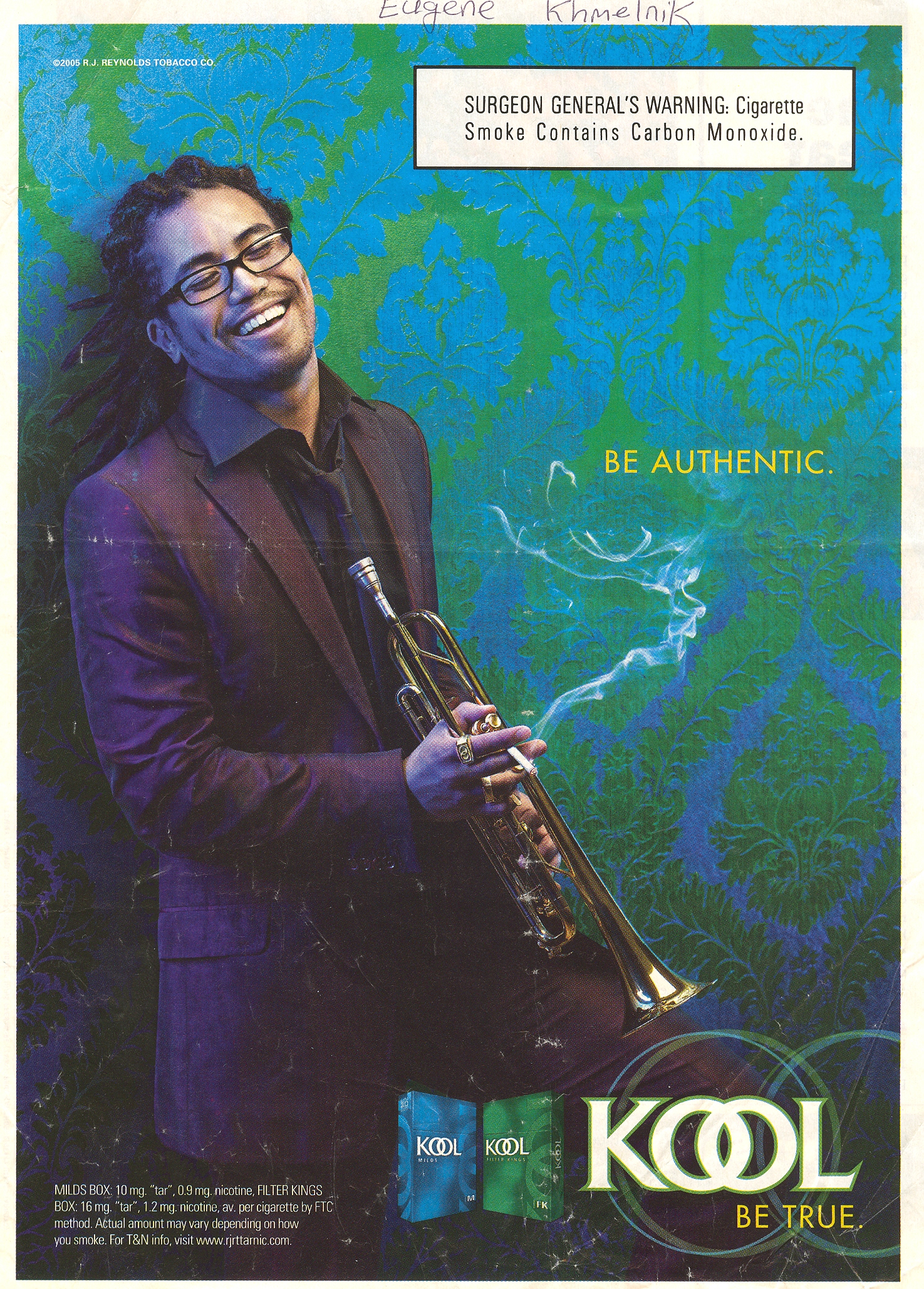Laura K. brought our attention to these ads with not-so-subliminal sexual content (via haha.nu). Some of them are so-not-so-subliminal that they may not be safe for work.
food/agriculture
From my hotel room in Gallup, NM: Katie H. sent in this picture of Jessica Simpson in a shirt that says “Real girls eat meat”:
Katie points out that this could be a really interesting contrast to the PETA PSAs using sexualized images of big-breasted blond celebrities to oppose eating meat and wearing fur.
But she also provided a link to PETA’s response to the photo, “Top Five Reasons Only Stupid Girls Brag about Eating Meat.” Note reason #4:
Meat will make you fat. All the saturated fat and cholesterol in chicken wings, pork chops, and steak eventually leads to flabby thighs and love handles. I hope the upcoming “Jessica Simpson’s Intimates” line comes in plus sizes! Going vegetarian is the best way to get slim and stay that way.
Katie pointed out that some of the other reasons play on the idea of attractiveness, too–compassion is “sexy” and the meat industry isn’t “hot.” It’s a very interesting connection between activism on behalf of animals and reinforcing ideals of femininity that focus on being thin and sexy above all else.
Thanks, Katie H.!
Daniel F. (who has a blog here) sent us this Temptation cookie ad from Mexico, which plays on the idea that men fear independent, strong women:
Daniel’s translation:
Host: Gentlemen, what we feared has happened. You have the new Mexican woman; she is more independent and gives more importance to what she wants.
First man: But, does she cool our beers?
Host: No, never again. And that’s not all. She also wants us to take our children to the pediatrician.
Second man: What’s that?
Host: Pediatrician is the doctor for kids.
Second man: No, the other thing, “children.”
Host: Children are the little people who call us dad.
Third man: And what is that she has in her hand?
Host: This, my friends, is the new Temptation cookie, because the new Mexican woman has her pleasures without guilt and, what’s worse, she doesn’t share.
Woman: Gentlemen, I’m leaving. I have things to do.
Narrator: There’s a new woman and she has new cookies.
The ad also connects sex and food and, in fact, replaces sexual pleasure (and men) with food, a theme Jean Kilbourne mentions in “Killing Us Softly 3”–that women are encouraged to use food to replace sex or console themselves when they have romantic troubles.
It’s also interesting that the ad plays on the idea of old-fashioned Mexican men who expect women to serve them.
Thanks, Daniel!
In case you hadn’t seen it already, this is the ad that is causing all the hullabaloo about Rachel Ray and Dunkin’ Donuts being in bed with Muslim terrorists (via lawgeek):
The incident might be useful in illustrating the social construction of social problems, moral panic, and racial politics after 911.
What is the relationship between the denigration of men as men and patriarchy? So long as we buy into the idea that we can’t expect men to be good partners or fathers, we will tolerate women’s responsibility for the second shift and their placement on the mommy track at work. So the Homer Simpson-esque sitcom dads and the Jackass teenagers, while incredibly degrading to men, also serve to perpetuate patriarchy.
Case in point:
Jessica at Feministing writes that this ad:
…feed[s] into the sexist idea that men deserve a cookie for being halfway decent human beings, but it also denigrates men by suggesting that they’re animals, unable to resist any ass that that happens to pass their way.
Another excellent example here.

Camilla P. sent us this international sampler of Coke Zero ads. She says all of them that she found use the whole “zero” is manlier than “diet” strategy (see the first two below), except the one in Australia which links a sip of Coke Zero with orgasm (see the third video).
From Britain:
From Brazil (we’d love someone to translate, although we think we get the gist):
From Australia:
If you liked that, see this remarkable Orangina commercial.
While whiteness is the neutral category (for example, see here and see here for the same phenomenon related to gender) and most, but not all, advertising is aimed at white people first, we all know that people of color DO appear in advertising, even when it’s obvious that the intended audience is mostly white. In this series, I’m going to offer some examples of how people of color are used in ads and some of the conditions under which they are included.
In this first post of the series, I offer you examples of ads that include people of color in order to associate the collectively-held meaning of the racial minority group (i.e., stereotypical traits, the social construction of the group) with the product.
This first one is my favorite (thanks to my student Kelly for submitting it). The product is Dole Fruit Gel Bowls. The text is: “There’s a feeling you get from the refreshing taste of real fruit. Lighten up with Reduced Sugar flavors. Life Is Sweet.” So how do they convince us that “Fruit Gel” is “real fruit”? By putting a “native” appearing woman with a “natural” hairstyle in a white cotton frock with flowers around her neck.
In this ad (thanks to my student, Jennifer, for submitting it) Verizon Broadband is telling us that we can download music fast. What kind of music? The kind associated with black folks, of course. The text along the top reads: “Jazz. Rock. Trip Hop. Uptempo or down.”
Compare that version of the ad with this one (thanks to my student, Laura). In this ad, the person is now an Asian woman and the type of music mentioned is “Classical. Soul. Hip Hop.”
This ad for IBM products features a middle aged Asian man, a type of person associated with high technology.

NEW: This ad uses an Asian man to invoke the idea of a good worker.
These two ads for Kool cigarettes (thanks to my student, Eugene, for the first one, and this blog for the second) use Black men doing stereotypically Black things (playing the trumpet and djing) in order to try to transfer some of the cool associated with Black men to Kool cigarettes. (Alternatively, these ads may be targeted directly at a Black audience.)

This one too:
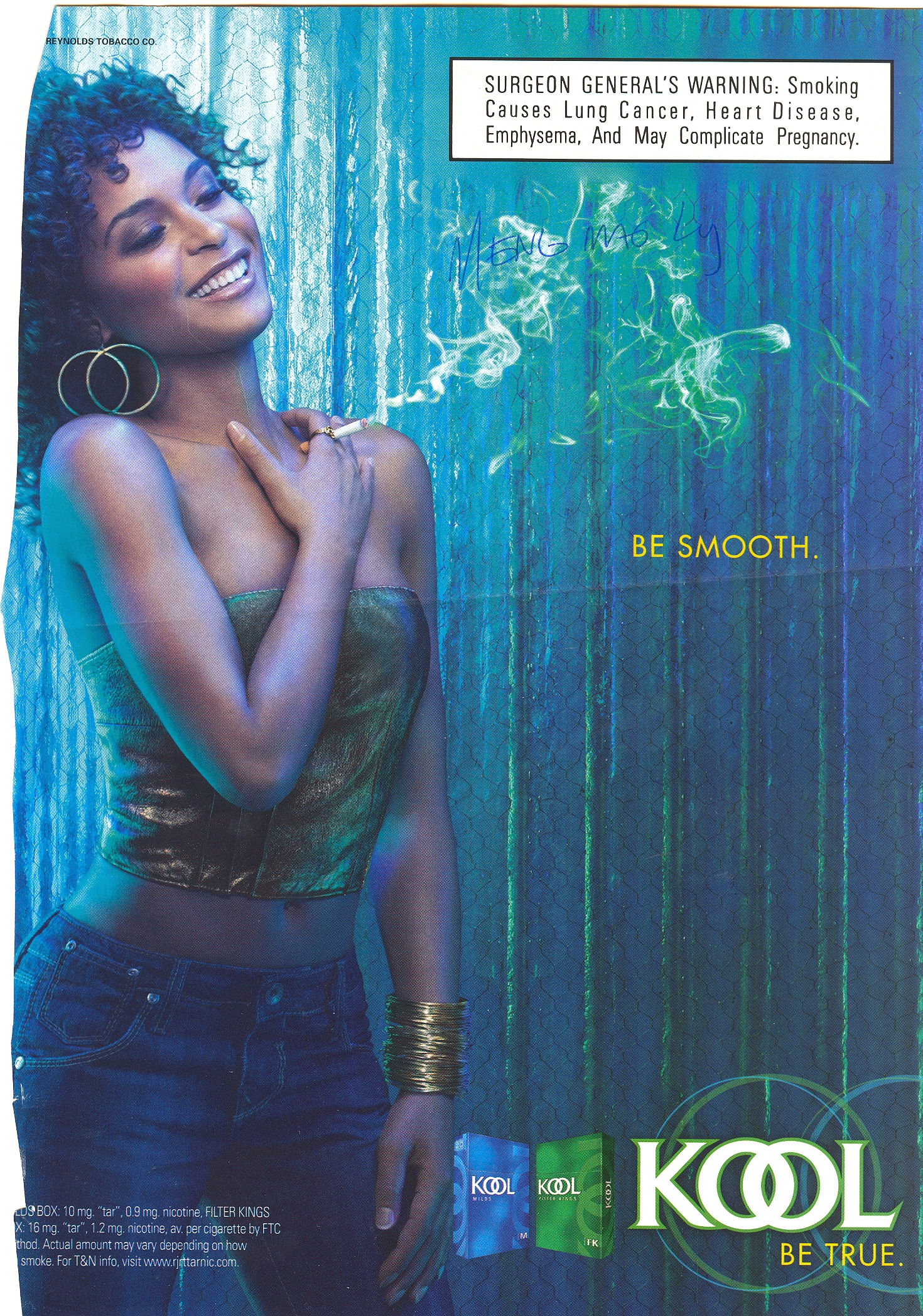
Finally, this ad for the Ipod ipod-type thing (submitted by my student, Cheng) uses a young Asian man dancing. We all know that white men can’t dance.
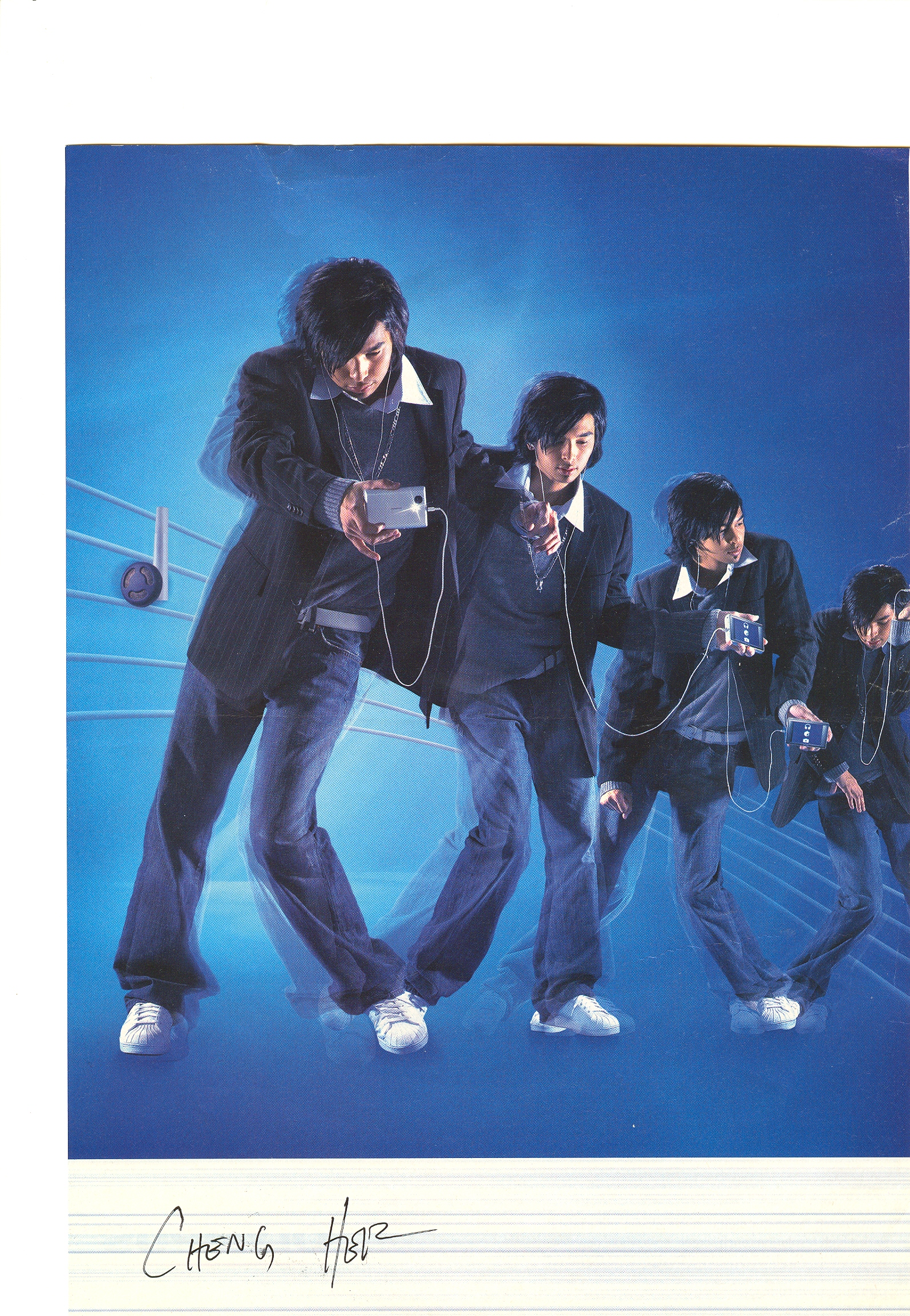
NEW! In this ad, rhythm is represented by a black woman:
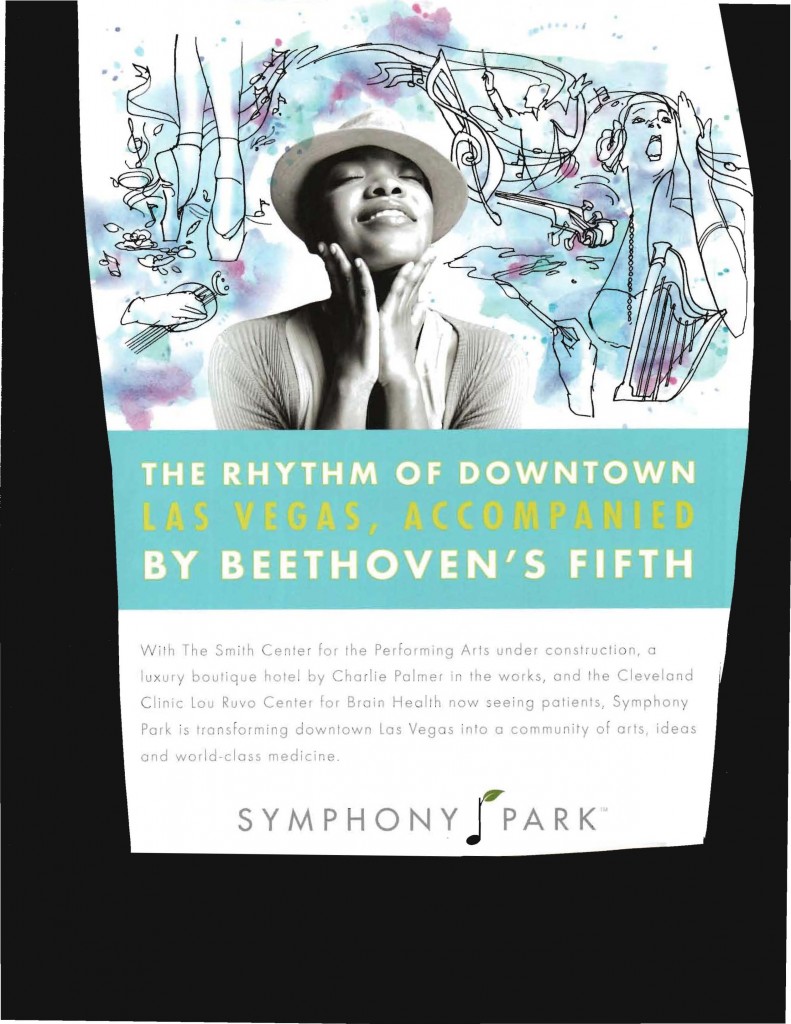
If anyone has more examples, I’d love to see them!
Next up: using people of color to signify, literally, color, or even spice or flavor.
From my hotel room in Gallup, NM: Katie H. sent in this picture of Jessica Simpson in a shirt that says “Real girls eat meat”:
Katie points out that this could be a really interesting contrast to the PETA PSAs using sexualized images of big-breasted blond celebrities to oppose eating meat and wearing fur.
But she also provided a link to PETA’s response to the photo, “Top Five Reasons Only Stupid Girls Brag about Eating Meat.” Note reason #4:
Meat will make you fat. All the saturated fat and cholesterol in chicken wings, pork chops, and steak eventually leads to flabby thighs and love handles. I hope the upcoming “Jessica Simpson’s Intimates” line comes in plus sizes! Going vegetarian is the best way to get slim and stay that way.
Katie pointed out that some of the other reasons play on the idea of attractiveness, too–compassion is “sexy” and the meat industry isn’t “hot.” It’s a very interesting connection between activism on behalf of animals and reinforcing ideals of femininity that focus on being thin and sexy above all else.
Thanks, Katie H.!
Daniel F. (who has a blog here) sent us this Temptation cookie ad from Mexico, which plays on the idea that men fear independent, strong women:
Daniel’s translation:
Host: Gentlemen, what we feared has happened. You have the new Mexican woman; she is more independent and gives more importance to what she wants.
First man: But, does she cool our beers?
Host: No, never again. And that’s not all. She also wants us to take our children to the pediatrician.
Second man: What’s that?
Host: Pediatrician is the doctor for kids.
Second man: No, the other thing, “children.”
Host: Children are the little people who call us dad.
Third man: And what is that she has in her hand?
Host: This, my friends, is the new Temptation cookie, because the new Mexican woman has her pleasures without guilt and, what’s worse, she doesn’t share.
Woman: Gentlemen, I’m leaving. I have things to do.
Narrator: There’s a new woman and she has new cookies.
The ad also connects sex and food and, in fact, replaces sexual pleasure (and men) with food, a theme Jean Kilbourne mentions in “Killing Us Softly 3”–that women are encouraged to use food to replace sex or console themselves when they have romantic troubles.
It’s also interesting that the ad plays on the idea of old-fashioned Mexican men who expect women to serve them.
Thanks, Daniel!
In case you hadn’t seen it already, this is the ad that is causing all the hullabaloo about Rachel Ray and Dunkin’ Donuts being in bed with Muslim terrorists (via lawgeek):
The incident might be useful in illustrating the social construction of social problems, moral panic, and racial politics after 911.
What is the relationship between the denigration of men as men and patriarchy? So long as we buy into the idea that we can’t expect men to be good partners or fathers, we will tolerate women’s responsibility for the second shift and their placement on the mommy track at work. So the Homer Simpson-esque sitcom dads and the Jackass teenagers, while incredibly degrading to men, also serve to perpetuate patriarchy.
Case in point:
Jessica at Feministing writes that this ad:
…feed[s] into the sexist idea that men deserve a cookie for being halfway decent human beings, but it also denigrates men by suggesting that they’re animals, unable to resist any ass that that happens to pass their way.
Another excellent example here.

Camilla P. sent us this international sampler of Coke Zero ads. She says all of them that she found use the whole “zero” is manlier than “diet” strategy (see the first two below), except the one in Australia which links a sip of Coke Zero with orgasm (see the third video).
From Britain:
From Brazil (we’d love someone to translate, although we think we get the gist):
From Australia:
If you liked that, see this remarkable Orangina commercial.
While whiteness is the neutral category (for example, see here and see here for the same phenomenon related to gender) and most, but not all, advertising is aimed at white people first, we all know that people of color DO appear in advertising, even when it’s obvious that the intended audience is mostly white. In this series, I’m going to offer some examples of how people of color are used in ads and some of the conditions under which they are included.
In this first post of the series, I offer you examples of ads that include people of color in order to associate the collectively-held meaning of the racial minority group (i.e., stereotypical traits, the social construction of the group) with the product.
This first one is my favorite (thanks to my student Kelly for submitting it). The product is Dole Fruit Gel Bowls. The text is: “There’s a feeling you get from the refreshing taste of real fruit. Lighten up with Reduced Sugar flavors. Life Is Sweet.” So how do they convince us that “Fruit Gel” is “real fruit”? By putting a “native” appearing woman with a “natural” hairstyle in a white cotton frock with flowers around her neck.
In this ad (thanks to my student, Jennifer, for submitting it) Verizon Broadband is telling us that we can download music fast. What kind of music? The kind associated with black folks, of course. The text along the top reads: “Jazz. Rock. Trip Hop. Uptempo or down.”
Compare that version of the ad with this one (thanks to my student, Laura). In this ad, the person is now an Asian woman and the type of music mentioned is “Classical. Soul. Hip Hop.”
This ad for IBM products features a middle aged Asian man, a type of person associated with high technology.

NEW: This ad uses an Asian man to invoke the idea of a good worker.
These two ads for Kool cigarettes (thanks to my student, Eugene, for the first one, and this blog for the second) use Black men doing stereotypically Black things (playing the trumpet and djing) in order to try to transfer some of the cool associated with Black men to Kool cigarettes. (Alternatively, these ads may be targeted directly at a Black audience.)

This one too:

Finally, this ad for the Ipod ipod-type thing (submitted by my student, Cheng) uses a young Asian man dancing. We all know that white men can’t dance.

NEW! In this ad, rhythm is represented by a black woman:

If anyone has more examples, I’d love to see them!
Next up: using people of color to signify, literally, color, or even spice or flavor.

